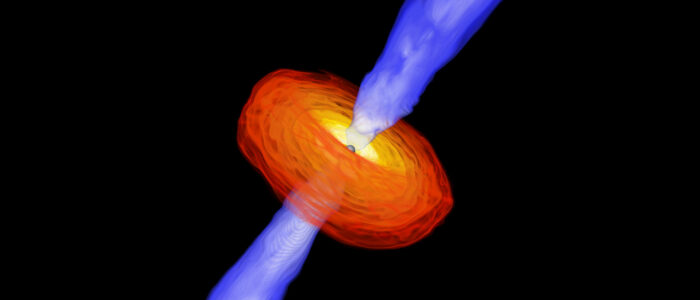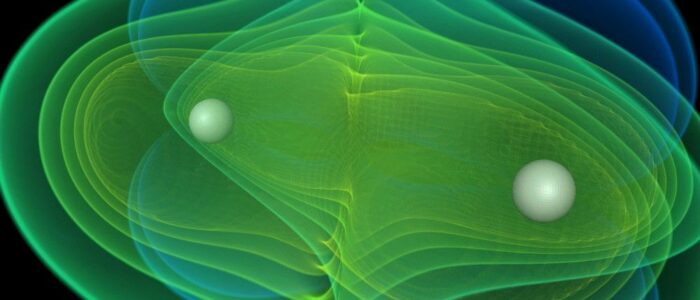What are relativistic jets?
In some extreme environments such as near black holes or other compact objects (see below), there is so much energy present that matter is expelled with enormous speed, ever so close to the speed of light. For reasons we have still to elucidate, matter expelled from such environments organizes in a collimated form, that is, it moves in a single direction, like water coming out of a hose. This collimation is the origin of the term “jet”, and the extreme near-light-speed motion of the matter in these jets is the origin of the word “relativistic”. Such an energetic process is a manifestation of extreme physical conditions (strong gravity, relativistic speeds) that cannot be accomplished in laboratories, and the great amount of energy and momentum carried by jets have significant effects in regulating the activities in the ambient environment, such as star formation and galaxy evolution. In these outflows, the behavior of matter becomes very unlike that of ordinary fluids such as the atmosphere, requiring a particular theoretical effort to describe it, and special computer simulations to understand them. At JETSET, we develop both of these areas of research.


What powers jets?
Relativistic jets are a ubiquitous phenomenon in a wide variety of astrophysical systems, from stellar scale X-ray binaries (XRBs) and gamma ray bursts (GRBs), to galactic scale active galactic nuclei (AGN) and tidal disruption events (TDE). Typical characteristics of jet sources are their relatively tiny physical size compared to their tremendous energy output. This combination leads to a very high efficiency of energy generation, placing a strong constraint on their energy source. The most efficient way of energy production in the solar system, nuclear fusion, only achieves an efficiency lower than 1%, far insufficient to power jet sources. A possible mechanism is compact object accretion, i.e. accumulation of matter onto a neutron star or black hole under gravitational attraction. During the accreting process, the gravitational energy of the accreted matter are extracted and transformed into kinetic and radiation energy, with an efficiency up to the order of 10% of rest mass energy! Such an incredible process is the only way to produce the extreme luminosity of jet sources.
How are jets launched?
One of the fundamental questions about jets is how they are launched from the central engine. Based on clear evidences of polarised synchrotron emission on jet spectra, nowadays magnetic fields are widely acknowledged as a key ingredient in the process of jet launching. There are two primary mechanisms of magnetically-driven jets: the Blandford-Znajek process and the Blandford-Payne process. The Blandford-Znajek process powers jets by extracting of the rotational energy of the spinning black hole from the ergosphere, whereas in the Blandford-Payne process, the jets are driven by the rotational energy of the accretion disk. Since a black hole does not possess magnetic field itself, in both launching mechanisms the magnetic field is produced by the accretion disk. The magnetic fieldlines are anchored to the disk, rotating with the disk, and threading into the ergosphere in the case of a rotating black hole. Around rotating black holes, both processes can work together to create a structured jet, with a faster black hole-driven “spine” coated in a slower disk-driven “sheath”. After the particles are launched from the central engine, they need to be accelerated to high energies to produce non-thermal emission (synchrotron, Comptonisation). The mechanism of particle acceleration is still controversial, with diffusive shock acceleration and magnetic reconnection being two leading candidates.
What is spacetime?

Contemporary physics understands that the notion of space and time depends on the state of motion of the observer, this is relativity. This stems from the outstanding yet firmly established fact that the speed of light is the same for all observers: even if you ran very very fast towards a flashlight pointed at you, you would still measure the same speed of the light passing by than if you were standing still. Space and time are a continuum referred to as spacetime. This spacetime is deformed by the presence of energy and matter. We experience this curvature through gravity, which dictates the trajectory of falling objects, like apples from trees on Earth. However, the fact that even light — which is massless — is deviated by massive objects such as the Sun hints to the fact that gravity is actually a geometrical feature (deformation, curvature) and not linked to a gravitational pull between masses. We also experience the curvature of spacetime through the passage of time, which is slower near massive objects than in weak gravitational fields. An experiment done time and time again consists in synchronizing two clocks and sending one on a couple of orbits around the Earth (further away from its gravitational field) on an airplane. When the airplane returns to Earth, the clocks are no longer synchronized.
What are compact objects?
Compact objects are astronomical bodies that concentrate a large mass in a small radius. Examples include white dwarfs, neutron stars, and black holes, which are the end-of-life state of massive stars. Typically, compact objects have the same mass as the Sun, but are Earth-sized (white dwarfs) or even kilometer-sized (neutron stars and black holes)! Because of their large mass and small radius, gravity is very strong in the vicinity of these objects, leading to extreme behavior such as the launching of relativistic jets. As fundamental actors in very energetic cosmic phenomena, contemporary astrophysics devotes considerable effort to understanding compact objects and their interactions.
What is numerical simulation?
A numerical simulation is a calculation using computers to study physical systems. In these simulations, a program implements one or more numerical methods to solve the physics equations that model the system. Of course, these simulations only allow an approximate study of the systems, both because the physics equations we solve are not a perfect description of Nature, and because the numerical methods do not allow to exactly solve these equations. Numerical simulations are required to study the behavior of systems whose mathematical description are too complex to provide analytical (i.e., pen-and-paper) solutions, such as most nonlinear systems. For example, Navier–Stokes equations, and Einstein field equations can be solved by finite-difference or finite-volume methods. In our studies, numerical simulation is used to solve Einstein field equations, general relativistic magnetohydrodynamics equations, equations of state of matter, radiation transfer equations, etc. altogether for the evolution of compact objects, relativistic jets and spacetime as we mentioned above. For more details on the tools we use to carry out numerical simulation at JETSET, see our Codes page.





